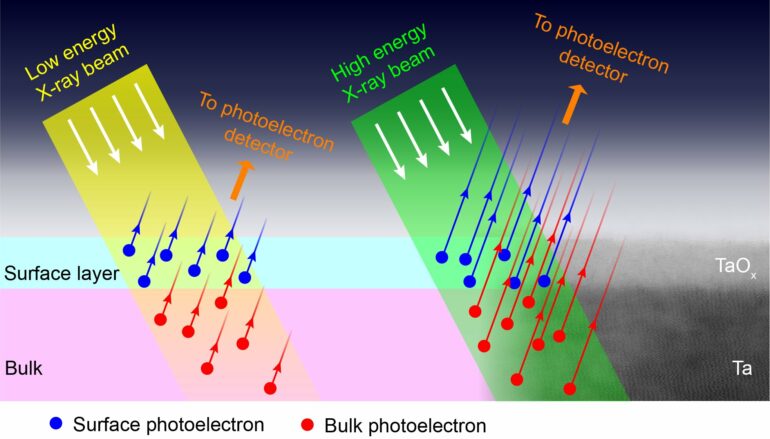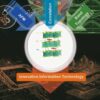Whether it’s baking a cake, building a house, or developing a quantum device, the quality of the end product significantly depends on its ingredients or base materials. Researchers working to improve the performance of superconducting qubits, the foundation of quantum computers, have been experimenting using different base materials in an effort to increase the coherent lifetimes of qubits.
The coherence time is a measure of how long a qubit retains quantum information, and thus a primary measure of performance. Recently, scientists discovered that using tantalum in superconducting qubits makes them perform better, but no one has been able to determine why—until now.
Scientists from the Center for Functional Nanomaterials (CFN), the National Synchrotron Light Source II (NSLS-II), the Co-design Center for Quantum Advantage (C2QA), and Princeton University investigated the fundamental reasons that these qubits perform better by decoding the chemical profile of tantalum.
The results of this work, which were recently published in the journal Advanced Science, will provide key knowledge for designing even better qubits in the future. CFN and NSLS-II are U.S. Department of Energy (DOE) Office of Science User Facilities at DOE’s Brookhaven National Laboratory. C2QA is a Brookhaven-led national quantum information science research center, of which Princeton University is a key partner.
Finding the right ingredient
Tantalum is a unique and versatile metal. It’s dense, hard, and easy to work with. Tantalum also has a high melting point and is resistant to corrosion, making it useful in many commercial applications. In addition, tantalum is a superconductor, which means it has no electrical resistance when cooled to sufficiently low temperatures, and consequently can carry current without any energy loss.
Tantalum-based superconducting qubits have demonstrated record-long lifetimes of more than half a millisecond. That is five times longer than the lifetimes of qubits made with niobium and aluminum, which are currently deployed in large-scale quantum processors.
These properties make tantalum an excellent candidate material for building better qubits. Still, the goal of improving superconducting quantum computers has been hindered by a lack of understanding as to what is limiting qubit lifetimes, a process known as decoherence. Noise and microscopic sources of dielectric loss are generally thought to contribute; however, scientists are unsure exactly why and how.
“The work in this paper is one of two parallel studies aiming to address a grand challenge in qubit fabrication,” explained Nathalie de Leon, an associate professor of electrical and computer engineering at Princeton University and the materials thrust leader for C2QA. “Nobody has proposed a microscopic, atomistic model for loss that explains all the observed behavior and then was able to show that their model limits a particular device. This requires measurement techniques that are precise and quantitative, as well as sophisticated data analysis.”
Surprising results
To get a better picture of the source of qubit decoherence, scientists at Princeton and CFN grew and chemically processed tantalum films on sapphire substrates. They then took these samples to the Spectroscopy Soft and Tender Beamlines (SST-1 and SST-2) at NSLS-II to study the tantalum oxide that formed on the surface using X-ray photoelectron spectroscopy (XPS). XPS uses X-rays to kick electrons out of the sample and provides clues about the chemical properties and electronic state of atoms near the sample surface.
The scientists hypothesized that the thickness and chemical nature of this tantalum oxide layer played a role in determining the qubit coherence, as tantalum has a thinner oxide layer compared to the niobium more typically used in qubits.
“We measured these materials at the beamlines in order to better understand what was happening,” explained Andrew Walter, a lead beamline scientist in NSLS-II’s soft X-ray scattering & spectroscopy program. “There was an assumption that the tantalum oxide layer was fairly uniform, but our measurements showed that it’s not uniform at all. It’s always more interesting when you uncover an answer you don’t expect, because that’s when you learn something.”
The team found several different kinds of tantalum oxides at the surface of the tantalum, which has prompted a new set of questions on the path to creating better superconducting qubits. Can these interfaces be modified to improve overall device performance, and which modifications would provide the most benefit? What kinds of surface treatments can be used to minimize loss?
Embodying the spirit of codesign
“It was inspiring to see experts of very different backgrounds coming together to solve a common problem,” said Mingzhao Liu, a materials scientist at CFN and the materials subthrust leader in C2QA. “This was a highly collaborative effort, pooling together the facilities, resources, and expertise shared between all of our facilities. From a materials science standpoint, it was exciting to create these samples and be an integral part of this research.”
Walter said, “Work like this speaks to the way C2QA was built. The electrical engineers from Princeton University contributed a lot to device management, design, data analysis, and testing. The materials group at CFN grew and processed samples and materials. My group at NSLS-II characterized these materials and their electronic properties.”
Having these specialized groups come together not only made the study move smoothly and more efficiently, but it gave the scientists an understanding of their work in a larger context. Students and postdocs were able to get invaluable experience in several different areas and contribute to this research in meaningful ways.
“Sometimes, when materials scientists work with physicists, they’ll hand off their materials and wait to hear back regarding results,” said de Leon, “but our team was working hand-in-hand, developing new methods along the way that could be broadly used at the beamline going forward.”
More information:
Russell A. McLellan et al, Chemical Profiles of the Oxides on Tantalum in State of the Art Superconducting Circuits, Advanced Science (2023). DOI: 10.1002/advs.202300921
Provided by
Brookhaven National Laboratory
Citation:
Understanding the tantalizing benefits of tantalum for improved quantum processors (2023, May 31)



